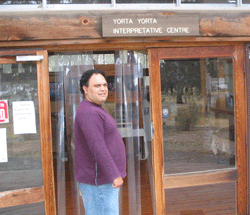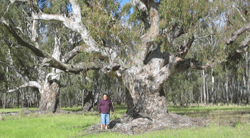Dharnya - Culture



Dharnya is the name for the cultural centre located in a traditional Indigenous meeting area and settlement of the Murray Darling basin. The area was the heartland of a remarkable Indigenous civilisation of to 70,000 Indigenous people, who lived in the vicinity in the time before the coming of Europeans. As a result of the efforts of the contemporary community, Dharnya remains an epicentre of Yorta Yorta cultural heritage. It is an ideal site for learning, for social and environmental business and for celebrating Yorta Yorta culture. Through the centre, the Yorta Yorta nation builds awareness and understanding of their culture amongst Indigenous and non-Indigenous people.<p>
Located 225 km north of Melbourne and half an hour from Echuca in the Barmah Forest, Dharnya includes a visitors centre, bunkhouse (in need of replacement), kitchen and mess hall (in need of renovation) and caretakers residence. It is set in the beautiful Barmah Forest which includes 30,000 hectares of floodplains and the worlds largest native River Red Gum forest.<p>
Dharnya has the potential to be a major hub for Indigenous enterprises generating revenue from tourism, developing Yorta Yorta culture and protecting the fragile environment and traditional lands of the area.<p>
<b>The Barmah Forest</b><p>
Barmah Forest covers nearly 30,000 hectares of Murray River (Dhungalla)
floodplains about 225 km north of Melbourne. Listed as a significant world
heritage wetlands area, the Barmah Forest is the worlds largest native River Red Gum (Dharnya) forest and features grey box, yellow box and black box woodlands, grasslands
and various wetland vegetations. The forest also features a variety of permanent and temporary wetlands, including lakes, swamps, lagoons and flooded forest. It is on a major flight path for migratory waterfowl and is an important breeding ground for many bird species.<p>
The Murray River (Dhungalla) within the forest area is a perched river (where the river
bed is higher than the surrounding land), another unique feature of this environment
and significant in the formation of the wetlands. The forests and wetlands of Barmah
are an important habitat for many animal species, including mammals, birds (219
species), reptiles (16 species) and amphibians (9 species).<p>
Combined with the Millewa forest over the border in NSW, the forests occupy
approximately 65,000 hectares of the Murray River floodplain and have been an
integral part of the life and culture of the Yorta Yorta people for some 60,000 years.
There are many sites of cultural significance for the Yorta Yorta people, including
middens and canoe trees throughout the forest.<p>
The Barmah Forest is subject to many international agreements, including the Ramsar
Convention for a Wetland of International Significance (1982) and the Japanese-Australia
Migratory Birds Agreement (1974), which recognises that certain birds migrate
between each country and thus habitats will be conserved. In 1986, there was a similar
agreement with China.<p>
Current buildings on the Dharnya site were established in 1985 by the Department of Conservation, Forests and Lands (DCFL). The Yorta Yorta people were consulted in concept and construction and share joint management of the centre with National Parks of Victoria. However, without a proper ability to invest in the development and marketing of the centre, and without a long term view of the development of the site, problems emerged simply due to the structure of the project. In a nutshell the project suffers from the limitations of having to conform with a public sector framework and committee structure and has no freedom to use income from the site to invest back into the maintenance of buildings and infrastructure. <p>
In its first seven years Dharnya Cultural Centre did relatively well. It received 20,000 visitors per annum, with many day visitors and numerous school groups using the bunkhouse accommodation and cookhouse facilities. Revenue was $40,00050,000 per annum when all sections were operating. <p>
However income from the site has not been sufficient for significant maintenance let alone upgrades of the buildings. Buildings at Dharnya need work to bring them up to a reasonable standard. While the buildings, particularly the bunkhouse lie in a state of disrepair, income flow and development of the site remain low, re-building is necessary to ensure that they meet regulations and are able to be used by visitors. Issues include building structure problems and lack of maintenance.<p>
In particular the replacement of the bunkhouse is a necessity. One current proposal is for tents to be built on raised ground at the site.
